1. Shoot straight and get the other guy first – dead enemies are no threat.
2. Avoid being seen and therefore shot at, by your expert fieldcraft and camouflage. The enemy can only shoot what he can see.
3. Stop the bullets and shrapnel which are coming your way with some effective body armour. Skin is pretty tender stuff but fortunately there are some tough fashion statements available to the modern soldier.
SHOOT FIRST AND SHOOT STRAIGHT
I am going to tread on some tender toes and upset people again here but my brief is to keep you alive – I don’t care about happy. That’s your mother’s job. Winning a shooting match is the best way of not getting shot. The simple premise being that a dead enemy is not going to shoot you. The trouble with this concept is that the enemy has exactly the same idea.
And, contrary to what a lot of armchair warriors say, insurgents are often very brave soldiers. They are not generally stupid either – even if some of them have some strange ideas about how their God wants them to live. We kill ten or a hundred of them for one of us by winning shooting matches on a regular basis not through mindless heroics. Why do you think that is? I will tell you here and now that the reason we win more than we lose is that we have better organization and we have better training.
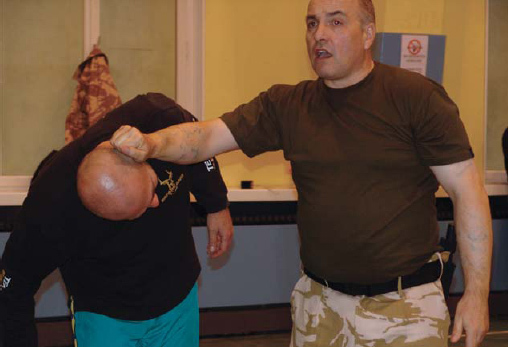
Whenever you possibly can, cheat to swing the odds in your favour. The Author demonstrates dirty tricks on a willing volunteer at the Military Academy, Vienna. (Author’s Collection)
Organization wins conflicts because it means having leaders at every level who know what they are doing so they come up with the right plan at the right time and then organize its execution properly. That might be your section commander, your platoon lieutenant, your squadron major, your battalion colonel or the general who makes all the big plans.
Training means every soldier is trained to operate efficiently like a cog in a machine. Reacting to a certain threat in a particular, effective, way by means of carrying out SOPs. Every soldier must know his personal soldiering skills inside out and be able to carry out the plans he is involved in exactly and to the letter. Playing your part in the plan means knowing your own job and, to my mind, understanding your part in the bigger picture in case something goes wrong and you have to improvise.
Get this right and we will win with minimum casualties – you may even get to stay alive forever. Get it wrong and men on our side will certainly die. Now for most of a soldier’s career there is someone above him making the plans but I have given you an introduction to tactics in this book so you have some idea what is happening. What we really need to look at in this section is your personal soldiering skills so we will start with covering a bit about shooting that you might not have learned on the range and a bit about ‘fire and movement’ that you might have forgotten.
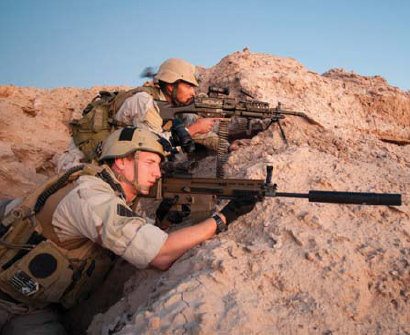
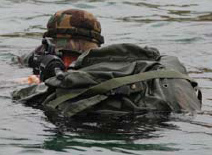
Intense training undertaken by units such as the US Navy SEALs ensure that they are crack shots no matter the terrain or circumstances. (US Navy SEALs and SWCC)
Combat shooting skills
The simple fact is that killing the enemy and staying alive are much more a function of aggression and clever tactics than good shooting. The safest way to fight a war is to open fire at several hundred metres like you see so often in the sand pit. This way each side fires off loads of ammunition until one side runs low then that side clears off. Casualties are very few but everyone thinks they had a hot battle. Bullshit, they wasted an opportunity to defeat the enemy.
Do you realize that currently only one enemy soldier is killed for every 10,000 rounds fired by NATO and ISAF forces? What sort of shooting do you call that? Pretty rubbish shooting by many standards but it is all down to opening fire at too great a range and this happens principally due to poor tactics. Get the enemy close before you open fire or you will waste ammunition and take risks for nothing.
My tally
In an effort to try to get you to take this seriously I will tell you something about my own efforts. Few soldiers talk about killing with the exception of snipers. But snipers are killing machines and see the enemy as scoring targets on a video game. Or they go mad.
I have killed more than 100 men in combat. Less than 10% of these have been more than 50m away when I pulled the trigger – though often in a firefight you are never exactly sure who made the kill. And less than 10% were within 5 or 10m. So nearly everyone I have shot has been between 10 and 50m away. How hard is it to shoot someone at 50m?
What does all this tell you? Several things I think:
1. To actually kill the enemy efficiently with a rifle it helps to get up close and personal
2. To get up close requires commitment on your part and gives you the edge
3. You don’t have to be a very good shot to hit someone at less than 50m
4. Up close you really, really do not want a stoppage
So what is there to learn about shooting if you are never going to shoot at long range? Plenty...
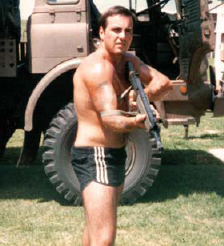
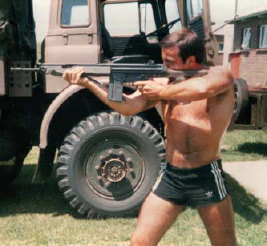
The Author training Special Forces troops in the art of snap shooting somewhere in Africa. Stock tight into shoulder, look over barrel. Balance weight between feet equally. Grip fore-stock well forward with vertical forearm. Pull weapon tight into shoulder with both hands. Raise rear elbow level to seat stock of weapon. Rise barrell onto target. Squeeze trigger – do not pull. (Author’s Collection)
Maintenance
Keeping your rifle working is probably as important as anything. If your rifle doesn’t fire when you pull the trigger then you are certainly no use to your team and you will probably die if someone comes for you. The aim of maintenance on any weapon is cleaning away the carbon build-up from the working parts and preventing dirt build-up and rust on the others. You clean away carbon with a wire brush, chemicals and a scraper then you apply oil as instructed for the particular weapon.
REMEMBER:
When you strip your weapon in the camp lay out the parts neatly but when you do it in the field place them in an upturned hat or similar to avoid loss.
You should practice stripping your weapon for cleaning until you can do it with a blindfold on – seriously. It is an excellent way of getting a soldier familiar with his weapon. Plus it is useful for when it is dark. If you allow carbon from the propellant burnt with each round fired to build-up then the rifle will start to jam as the fresh round will not feed into the chamber correctly, the breech will not close and lock to allow firing or the gas pressure will not be sufficient to drag the sticking empty cartridge out of the chamber.
Your weapon needs to be protected from the main enemies of all mechanical toys: rust and sand. The more finely crafted the weapon the more it suffers from a few grains of sand in the working parts. Most Western weapons are made to such fine tolerances that a small amount of sand brings everything to a halt. The Russian and Chinese Kalashnikovs, on the other hand, are made so loose that the working parts rattle when you shake them. A surprising amount of sand or mud will entirely fail to stop them working. There is a lot of sense in that. But what do you do with the Swiss watch of a rifle with which you have been issued? Consider this: